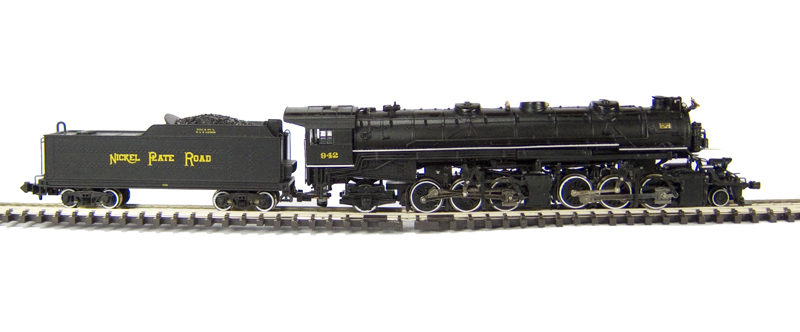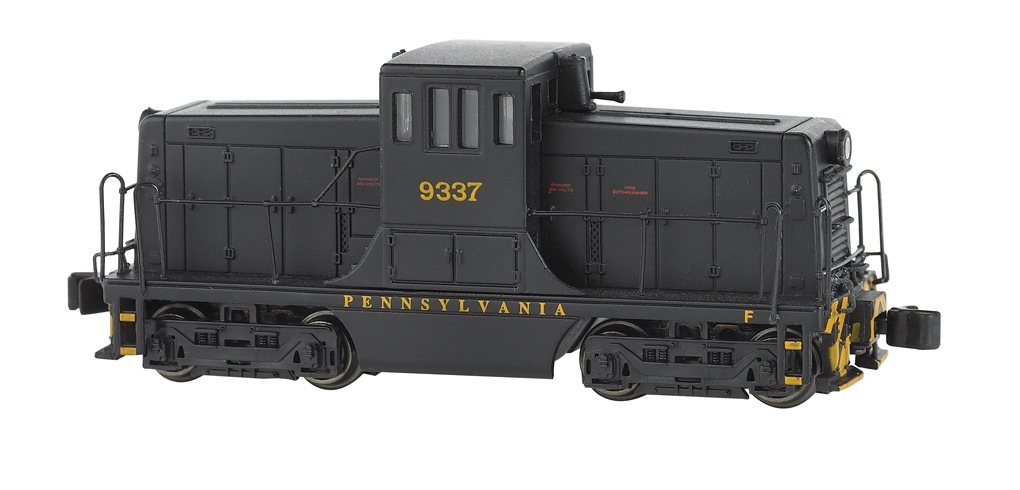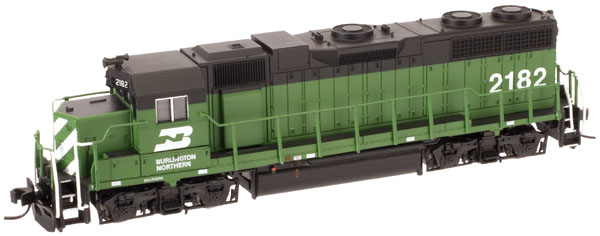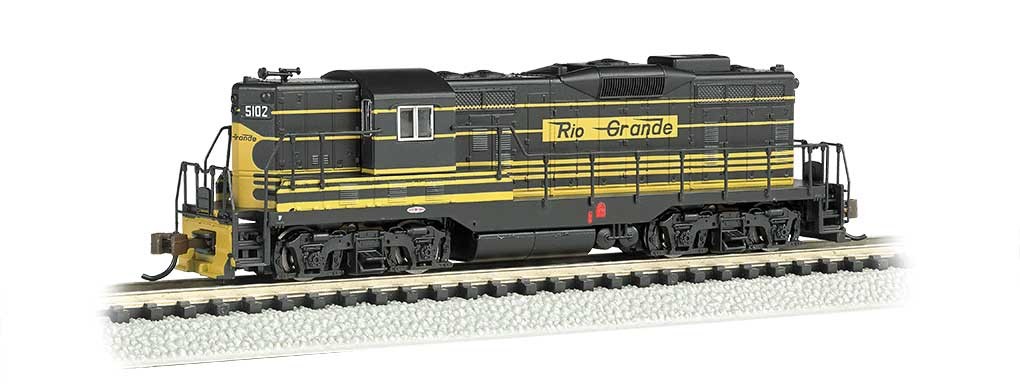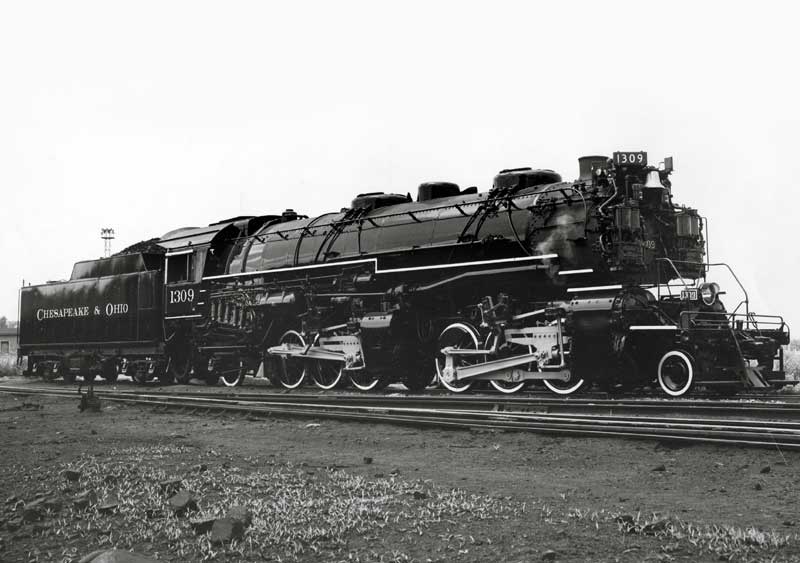Model Information: First released in 2005 and released as the USRA Mallet. Bachmann later re-used the same mechanism for a C&O H-4 model which was released in 2010 with a Vanderbilt VC12 tender. The USRA Mallets come with Rapido coupler on the tender and a dummy knuckle coupler in the front. The H-4's come with EZ-Mate couplers.
Features include:
Features include:
- DCC ready (manufacturer's view...)
- 5 pole, skew-wound motor
- powered by all drivers
- amber LED headlight
- detailed cab interior
- separate detail parts, including bell, whistle, pop valves, and hand rails
- finescale driver spokes
DCC Information: The 2005 USRA Mallet is DCC-Friendly. No PCB nor plug, but some space reserved for a decoder and wires available in the vicinity.
The 2010 H-4 comes with DCC factory installed in the tender.
The 2010 H-4 comes with DCC factory installed in the tender.
Prototype History: The USRA 2-6-6-2 locomotive was a Mallet, or compound articulated type, having both low-pressure and high-pressure cylinders. The smaller high-pressure cylinders powered the rear set of driving wheels, and the larger low-pressure cylinders powered the forward set of driving wheels. The USRA 2-6-6-2 articulated locomotives were direct developments of the Chesapeake & Ohio class H-2 and H-4 series. This type of locomotive was sometimes referred to as a Mallet Mogul.
150 H-4s were built at Schenectady and Richmond between 1912 and 1918 for the C&O. Individual H-4 batches had adhesion weights ranging from 358,000 to 364,900 lb.
During 1919 and 1920 the C&O received batches of its Class H-5's and Class H-6's becoming the last new compounds to arrive on the railroad for nearly 30 years. The locomotives were numbered 1520-1539 (H-5) and 1475-1519 (H-6).
From Wikipedia
Read more on american-rails.com about the C&O 2-6-6-2's
150 H-4s were built at Schenectady and Richmond between 1912 and 1918 for the C&O. Individual H-4 batches had adhesion weights ranging from 358,000 to 364,900 lb.
During 1919 and 1920 the C&O received batches of its Class H-5's and Class H-6's becoming the last new compounds to arrive on the railroad for nearly 30 years. The locomotives were numbered 1520-1539 (H-5) and 1475-1519 (H-6).
From Wikipedia
Read more on american-rails.com about the C&O 2-6-6-2's
Road Name History: 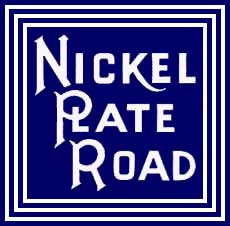 The New York, Chicago and St. Louis Railroad (reporting mark NKP), abbreviated NYC&St.L, was a railroad that operated in the mid-central United States. Commonly referred to as the Nickel Plate Road, the railroad served a large area, including trackage in the states of New York, Pennsylvania, Ohio, Indiana, Illinois and Missouri. Its primary connections included Buffalo, Chicago, Cincinnati, Cleveland, Indianapolis, St. Louis, and Toledo.
The New York, Chicago and St. Louis Railroad (reporting mark NKP), abbreviated NYC&St.L, was a railroad that operated in the mid-central United States. Commonly referred to as the Nickel Plate Road, the railroad served a large area, including trackage in the states of New York, Pennsylvania, Ohio, Indiana, Illinois and Missouri. Its primary connections included Buffalo, Chicago, Cincinnati, Cleveland, Indianapolis, St. Louis, and Toledo.
The Nickel Plate Railroad was constructed in 1881 along the South Shore of the Great Lakes connecting Buffalo and Chicago to compete with the Lake Shore and Michigan Southern Railway. In 1964 the Nickel Plate Road and several other mid-western carriers were merged into the larger Norfolk and Western Railway (N&W). The goal of the N&W expansion was to form a more competitive and successful system serving 14 states and the Canadian province of Ontario on more than 7,000 miles (11,000 km) of railroad. The profitable N&W was itself combined with the Southern Railway, another profitable carrier, to form Norfolk Southern Corporation (NS) in 1982.
At the end of 1960 NKP operated 2,170 miles (3,490 km) of road on 4,009 miles (6,452 km) of track, not including the 25 miles (40 km) of Lorain & West Virginia. That year it reported 9758 million net ton-miles of revenue freight and 41 million passenger-miles.
The Nickel Plate Historical and Technical Society works to preserve the memory of the Nickel Plate Road.
From WIkipedia

The Nickel Plate Railroad was constructed in 1881 along the South Shore of the Great Lakes connecting Buffalo and Chicago to compete with the Lake Shore and Michigan Southern Railway. In 1964 the Nickel Plate Road and several other mid-western carriers were merged into the larger Norfolk and Western Railway (N&W). The goal of the N&W expansion was to form a more competitive and successful system serving 14 states and the Canadian province of Ontario on more than 7,000 miles (11,000 km) of railroad. The profitable N&W was itself combined with the Southern Railway, another profitable carrier, to form Norfolk Southern Corporation (NS) in 1982.
At the end of 1960 NKP operated 2,170 miles (3,490 km) of road on 4,009 miles (6,452 km) of track, not including the 25 miles (40 km) of Lorain & West Virginia. That year it reported 9758 million net ton-miles of revenue freight and 41 million passenger-miles.
The Nickel Plate Historical and Technical Society works to preserve the memory of the Nickel Plate Road.
From WIkipedia
Brand/Importer Information: Bachmann Industries (Bachmann Brothers, Inc.) is a Bermuda registered Chinese owned company, globally headquartered in Hong Kong; specializing in model railroading.
Founded in Philadelphia, Pennsylvania, the home of its North American headquarters, Bachmann is today part of the Kader group, who model products are made at a Chinese Government joint-venture plant in Dongguan, China. Bachmann's brand is the largest seller, in terms of volume, of model trains in the world. Bachmann primarily specializes in entry level train sets, and premium offerings in many scales. The Spectrum line is the high quality, model railroad product line, offered in N, HO, Large Scale, On30, and Williams O gauge all aimed for the hobbyist market. Bachmann is the producer of the famous railroad village product line known as "Plasticville." The turnover for Bachmann model trains for the year ended 31 December 2006 was approximately $46.87 million, a slight increase of 3.36% as compared to 2005.
Founded in Philadelphia, Pennsylvania, the home of its North American headquarters, Bachmann is today part of the Kader group, who model products are made at a Chinese Government joint-venture plant in Dongguan, China. Bachmann's brand is the largest seller, in terms of volume, of model trains in the world. Bachmann primarily specializes in entry level train sets, and premium offerings in many scales. The Spectrum line is the high quality, model railroad product line, offered in N, HO, Large Scale, On30, and Williams O gauge all aimed for the hobbyist market. Bachmann is the producer of the famous railroad village product line known as "Plasticville." The turnover for Bachmann model trains for the year ended 31 December 2006 was approximately $46.87 million, a slight increase of 3.36% as compared to 2005.
Item created by: Alain LM on 2018-06-21 14:35:24. Last edited by Alain LM on 2018-06-21 14:36:00
If you see errors or missing data in this entry, please feel free to log in and edit it. Anyone with a Gmail account can log in instantly.
If you see errors or missing data in this entry, please feel free to log in and edit it. Anyone with a Gmail account can log in instantly.



